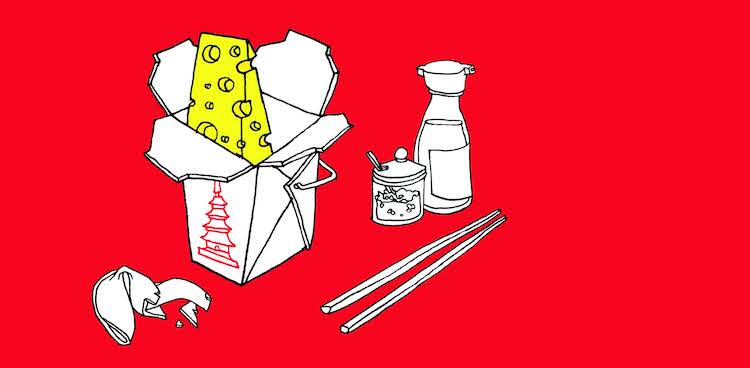
Between 2007 and 2008, I lived in Beijing, China, with my friend, Ellen, the Cheddar Shark. The food we ate was amazing, but a question quickly arose: Why was there no Chinese cheese? After all, the region is surrounded by dairy-loving neighbors—the Tibetans, who like their cheese crunchy; the Mongolians, for whom it represents purity; the sheep-herding Uyghirs; and, of course, cow-venerating Indians. But the ethnic Han in northern China don’t share this enthusiasm for cheese.
The historical explanation is that crowded conditions made pasture animals impractical, so lack of exposure led to widespread lactose intolerance. But forget history and forget digestion. My friend Danwen, a local, gave it to me straight:
“I can’t eat cheese. It’s not the flavor; it’s psychological.”
Curdled, moldy milk just doesn’t appeal to many Chinese. The country’s culinary diversity is vast, however, and cooked milk shows up occasionally in hot dishes like fried milk or in sweets like gongting nailao, a flan-ish concoction I like very much.
Still, foreign-style cheese is making inroads; Dutch entrepreneur Marc de Ruiter makes farmhouse-style Gouda in Beijing under the Yellow Valley brand, and native cheesemaker Liu Yang has attracted attention recently with his pioneering Le Fromagier de Pekin, where he makes the appropriately named Beijing Gray Camembert.
But for real Chinese-style cheese, you’ve got to go south. In Yunnan province, ethnic minorities like the Sani, Bai, and Naxi do dairy. Rushan (“milk-fan”) is the more exotic variety, featuring air-dried strips made from cow’s milk, thin as American bacon, which are twisted around a dot of sweet red bean, then deep fried. More conventional is rubing, a goat cheese; think haloumi or paneer, as it doesn’t melt, so you can cook it like tofu, or just fry it in a pan and serve sweet or salted. Outside Yunnan, though, most natives eat their cheese as a topping: Pizza Hut, McDonald’s, and Subway are all popular venues that serve cheese. That’s too bad, considering that right next door, Korea and Japan are integrating cheese into their cuisine with amazing results.
As with Spam, Koreans have made a virtue out of bland Velveeta-style industrial brick, rolling it into the sushi-like kimbab with vegetables and rice. (I’m less enthusiastic about cheese ramyun, a big bowl of instant noodles with a single Kraft slice melting on top, but it has the virtue of easy replication. American college kids can now produce an authentic Korean meal in just minutes!) Sadly, I never got the name of my favorite Korean cheese dish, which I found in the basement cafeteria of a Christian day school. It was basically lasagna but made of fried rice with kimchee and ham, layered with mozzarella, and baked in a dish. Homey, spicy, and amazing.
The Japanese have taken a more serious route with their curds. On the northern island of Hokkaido, dairy farmers are making some of the best cheeses in the world. Case in point: Shintoku Farm’s Sakura cheese won the gold medal in the flavored soft cheese category at the third Mountain Cheese Olympics in 2004. Hokkaido cheese is being eaten à la carte, and is finding its way into dishes like ramen, with very satisfying results.
With these deeply tasty innovations just beyond their borders, I have to wonder: If the Chinese ever embrace it, what will they accomplish with cheese? I am hopeful, remembering the comment of Miao, another friend from Beijing, who split a wedge of Danish blue with me and the Cheddar Shark one night. “I don’t normally eat cheese,” she remarked, “but this is much better. . . You know, it has a real flavor.



